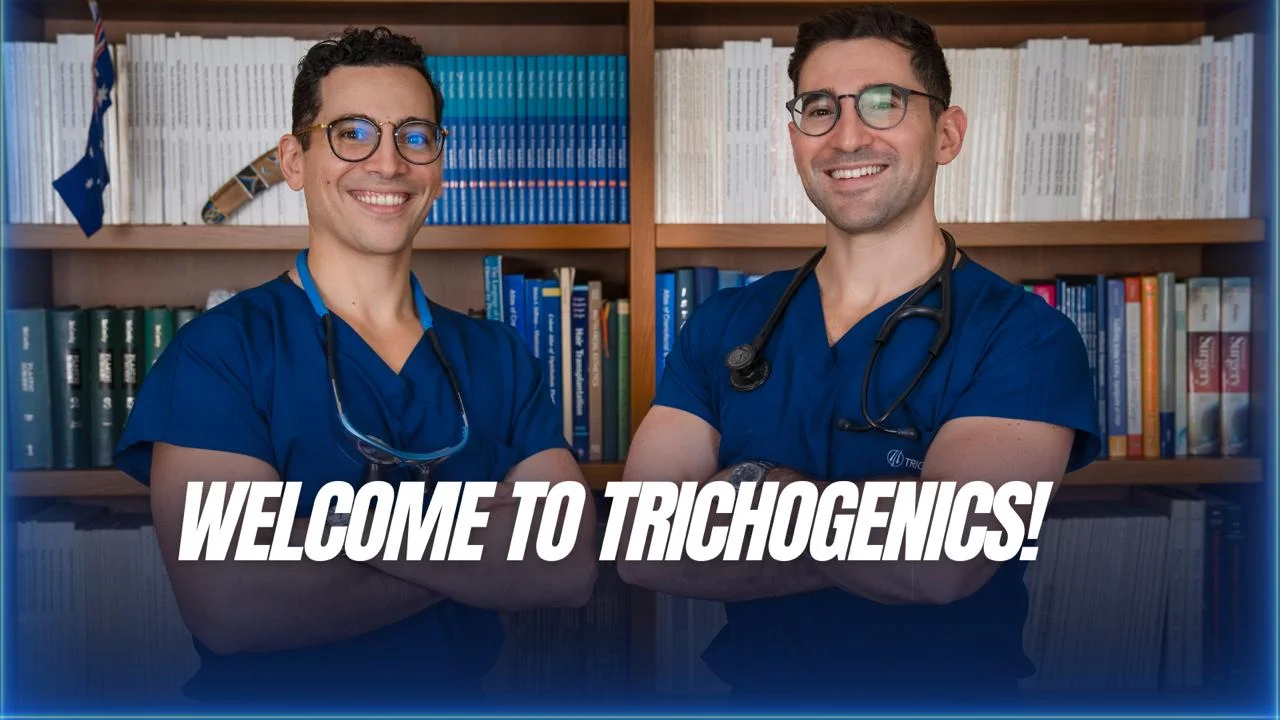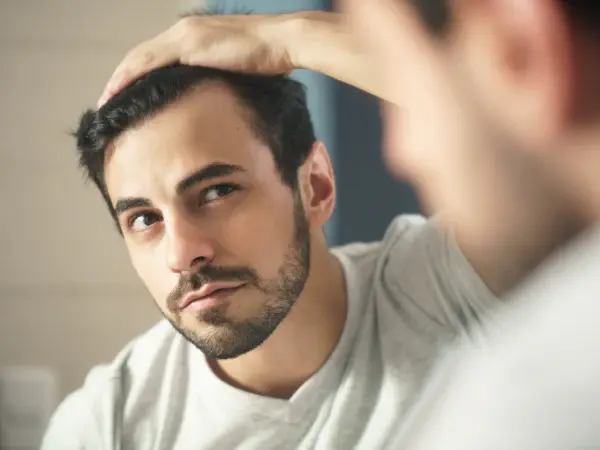At Trichogenics, Dr. Asi and Dr. Eric Peretz frequently receive questions from patients. They want to know when they can rub their heads after a hair transplant. A key step in recovery, understanding when it’s safe to touch your scalp ensures the success of your results.
Most patients can safely touch or rub their scalp about two to four weeks after surgery, after the grafts fully anchor. The answer to when can I rub my head after hair transplant depends on your healing speed and your surgeon’s instructions.
During the first 14 days, the transplanted area is still fragile, so rubbing or scratching can dislodge grafts and slow recovery.
After the scalp heals, gentle contact and massage can help improve circulation and comfort. Always confirm with your hair transplant surgeon before resuming normal scalp care.
Key Takeaways
- Touching or rubbing the scalp too soon after a hair transplant can dislodge grafts and delay healing, so patients should avoid any contact during the first days.
- Mild itching after a hair transplant is normal and can be managed with gentle washing, moisturizing sprays, and anti-inflammatory medication prescribed by the doctor.
- Patients can usually wash their hair gently after three days but should wait at least 14 days before normal touching or rubbing to protect the transplanted area.
- Light massage and daily care can resume after the scalp fully heals, typically around four weeks, always following the surgeon’s instructions.
- Choosing Trichogenics in Greece or Israel, under Dr. Asi and Dr. Eric Peretz, ensures a safe, doctor-performed procedure—unlike the unregulated and unsafe conditions found in many Turkish clinics.
Why You Should Avoid Touching or Rubbing Early
During the first days after a hair transplant procedure, the transplanted area is extremely sensitive. Touching or rubbing it can dislodge the grafts before they anchor to the scalp. These newly transplanted hairs need stability to survive and grow.
You should avoid touching the recipient area completely during the first few days. Even gentle pressure can interfere with the healing process. The goal is to keep the scalp clean, dry, and protected while the donor area and grafts begin to heal.
@trichogenics Hair transplant basics. The concept of coverage value for proper donor area management. #hairtransplant #hairtransplantgreece #hairtransplantturkey #hairlosssolutions #hairloss #hairfall #finasteride #trichogenics #minoxidil #finastride #coveragevalue #fue #fyp
♬ original sound - Trichogenics
How Grafts Heal in the First Weeks
In the first 14 days, the grafts go through three phases—attachment, healing, and adaptation. Tiny scabs will form around each graft, which is a natural part of the post-operative recovery process.
Avoid scratching these scabs, as doing so may cause hair loss in the transplanted follicles.
During this stage, your hair transplant surgeon will likely prescribe anti-inflammatory medication to reduce swelling and prevent infection. Following these instructions closely helps maintain healthy hair growth later on.
Hair Transplant Itching: What’s Normal and How to Manage It
Feeling itchy after hair transplant is very common. It’s part of the healing process as the skin regenerates. This sensation can occur both in the donor area and the recipient area.
To manage it, avoid rubbing or scratching the scalp. Instead, follow your surgeon’s advice on gentle washing or moisturizing sprays. If the itching becomes intense, ask about safe anti-inflammatory or soothing topical treatments.
Scalp Care and Safe Contact Timeline
After surgery, caring for your scalp correctly helps your grafts take root. Knowing when to touch or wash your head prevents accidental damage.
When Can I Touch or Wash My Head Normally After Hair Transplant
Patients can usually begin washing your hair carefully after 3 days, using only gentle motions. Wait at least 14 days before touching your scalp normally. At that point, the grafts are typically stable and less prone to dislodging.
Can I Touch Grafts After 5 Days?
No—avoid direct contact with the grafts at 5 days. They are still fragile and could detach easily.
By the end of the second week, touching or patting lightly while washing your hair is generally safe, but always confirm with your hair transplant surgeon first.
Safe Washing, Drying, and Gentle Handling Tips
- Use lukewarm water and mild, fragrance-free shampoo.
- Let the water run over your head without pressure.
- Pat dry with a soft towel—never rub.
- Avoid hair dryers for the first two weeks.
This gentle washing routine minimizes trauma to the scalp and supports the recovery process.
Relieve Itching and Support Recovery
When Can I Scratch or Massage My Head After Hair Transplant
Do not scratch or massage the scalp during the first two weeks. Even mild rubbing can disturb the grafts. Once the healing phase progresses, your doctor may allow light massage to improve blood circulation.
Gentle Techniques to Reduce Discomfort and Promote Healing
After the 14 days mark, you can gently massage the scalp with your fingertips. Use soft, circular motions to stimulate the skin and relieve tension. This improves blood flow, promoting healthy hair growth and faster recovery.
If itch after a hair transplant continues, it’s often due to dryness. A sterile saline spray or light moisturizer recommended by your doctor can help ease the discomfort.
@trichogenics What to do if you have some burning or itching after a hair transplant. Dr Eric Peretz explains. #hairtransplant #trichogenics #hairtransplantturkey #hairtransplantsurgery #hairtransplantgreece #hairlosssolutions #hairloss #hairfall #hairtransformation#fyp
♬ original sound - Trichogenics
Lifestyle and Activity Restrictions After Surgery
Can We Masturbate After a Hair Transplant?
It’s advised to avoid sexual activity for at least 7 days after surgery. Physical strain and increased blood pressure can affect the transplanted area, potentially dislodging grafts.
Other Activities to Avoid During Recovery
Until the grafts are fully settled, avoid:
- Heavy exercise and gym workouts.
- Sun exposure without protection.
- Wearing tight hats or helmets.
- Swimming in pools or the sea.
Each of these can irritate the recipient area or introduce bacteria that slow down the recovery process.
Long-Term Care and When to Contact Your Surgeon
When It’s Finally Safe to Rub Your Head
By 4 weeks, the scalp has typically healed enough to tolerate light rubbing. Still, use care. Avoid harsh friction even after a month. Always prioritize gentle washing and mild contact when cleaning or styling your hair.
Signs of Infection, Pain, or Graft Problems
Contact your surgeon if you experience:
- Persistent redness or swelling after 14 days.
- Unusual pain or pus around grafts.
- Sudden shock loss of newly transplanted hairs.
Early medical attention prevents complications and protects your results.
Maintaining Healthy Hair Growth and Scalp Protection
Long-term care includes:
- Eating a balanced diet rich in vitamins and proteins.
- Avoiding harsh chemical products.
- Using mild shampoos and conditioners.
- Protecting your scalp from the sun.
These habits support consistent hair growth and protect your results.
Why Choose Trichogenics in Greece and Israel Over Clinics in Turkey
Unlike many unregulated clinics in Turkey, Trichogenics operates under strict medical standards. All procedures are doctor-performed, ensuring safety and consistent results.
In Turkey, many operations are handled by technicians without medical oversight, putting patients at risk of infection or poor outcomes.

At Trichogenics, Dr. Asi Peretz and Dr. Eric Peretz personally perform each hair transplant procedure using advanced tools and sterile techniques. Their expertise minimizes risks and guarantees natural results.
Patients receive follow-up care from licensed specialists in Greece and Israel, two safe, regulated countries with strong medical systems.
Choosing a medically supervised clinic like Trichogenics means peace of mind, professional care, and lasting healthy hair results.



